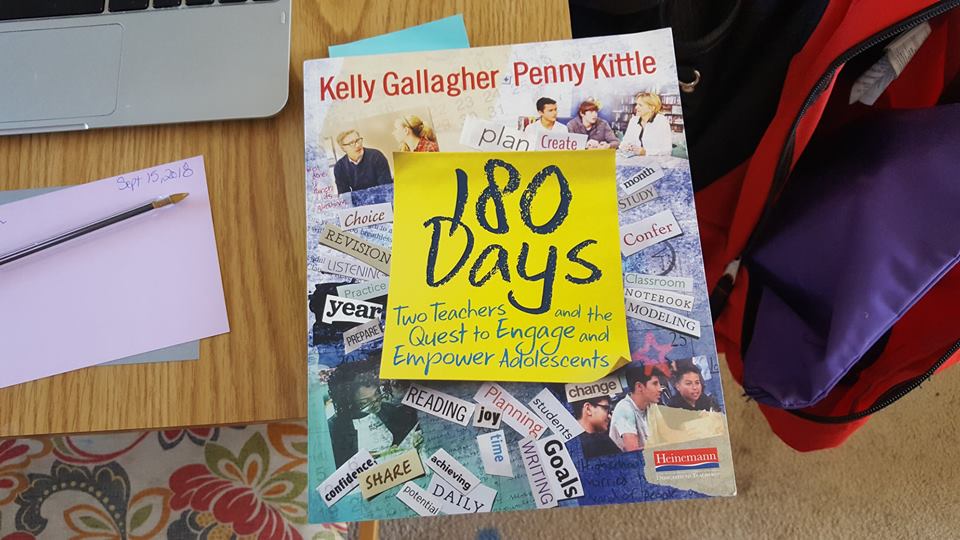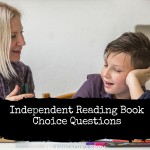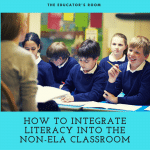As an ELA teacher, I do a lot of reading. During the school year I try to read as much Young Adult Lit as possible so I can share it with my 8th graders, but during the summer I read more adult titles and I try to squeeze in at least one professional title. Last summer I read Disrupting Thinking: Why How We Read Matters (2017) by Kylene Beers and Robert Probst and it transformed the way I taught full-class and individual choice texts. This summer the title I chose was 180 Days: Two Teachers and the Quest to Engage and Empower Adolescents by Kelly Gallagher and Penny Kittle.
I’ve long been a fan of both Gallagher and Kittle, consuming their previous works like Readicide (Gallagher 2009) and Book Love (Kittle 2013). In fact, when I moved from teaching high school juniors and seniors for eleven years to our district’s junior high five years ago, I remodeled my entire classroom around their ideas about Reader’s Workshops and giving students the choice in what they read and write.
It has been wildly successful not just in student engagement (or re-engagement for many students) with books, but also with the data that administrators love: students read more, so their reading level and test scores have improved.
When I saw that two of my favorite educators were teaming up to write a book describing how they both incorporate into their classes not just Reader’s Workshop but also writing, I knew what my summer reading was going to be.

The book begins with a chapter that orients the reader to the beliefs that both Gallagher and Kittle hold. If you familiar with their previous work, this chapter is a bit of a review, but I found it helpful as I sought inspiration going into a new school year. They also spend time talking about the daily practices they incorporate into the rhythms of their classrooms.
The chapters that follow map out their school year of both reading and writing. While Kittle and Gallagher both focus mostly on independent choice reading, they both also teach full class texts. Critics have argued that these two teachers have so much freedom to choose their curricula, that their yearly maps are unhelpful to the “rest of us.” I found this to be untrue.
While I do have required texts that I don’t necessarily get to choose, I felt like their suggestions for pacing and using essential questions were helpful. I also found the advice to decide before reading the text which skills (in my case CCSS) would be highlighted. It seems ridiculous, but it was a revolutionary to me to not try to do all the things with every full-class text I teach.
The chapters that were most helpful to me were the ones in Section II of the book: Teaching Essential Discourses. This is where they broke down the four types of writing they focus on during the school year: Narrative, Informational, Argument, and Multigenre. We also focus on the first three writings, even in the same order as Kittle and Gallagher, so I have been using those chapters as sort of a reference as my students head through our first quarter with narrative writing.
While I read the book through in its entirety, I currently have the “Narrative” chapter full of post-its and dog-eared corners. We are reading a novel together, but we are also studying what a narrative can be. And with Kittle and Gallagher’s help, I have been armed with a diverse array of mentor texts and writing prompts to get my 8th graders thinking and writing their own stories.
[bctt tweet=”With Kittle and Gallagher’s help, I have been armed with a diverse array of mentor texts and writing prompts to get my 8th graders thinking and writing their own stories.” username=””]
One thing I really appreciate about Kittle and Gallagher is that they give assessment space in their book. They talk about taking “laps” with the teaching of each genre, and that assessment matches student exposure to reading and writing in that genre. I’ve modeled this idea of “laps” this year with my 8th graders. So far we have written 6-word memoirs and just completed 100-word memoirs (145), and will soon be starting our own choice of a narrative scene (163). Each time we take a lap around writing narratives, the assessment gets more specific. It has been freeing to not feel like I have to grade every single thing my students write or grade everything with incredible precision.
As I look ahead to the informational writing we will do next marking period, I am already marking up my copy of 180 Days as a reference to bring in complex texts as mentors as well as more creative ones.
*Disclosure: Heinemann provided me with a copy of 180 Days to read and review; however, all opinions are my own. I was not compensated by Heinemann for this article.




